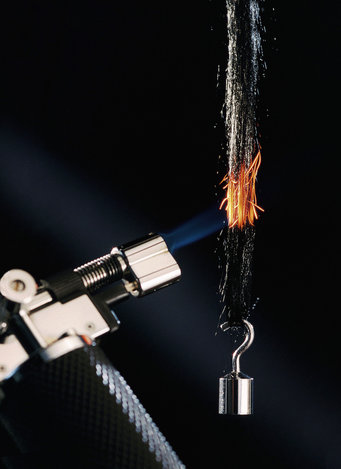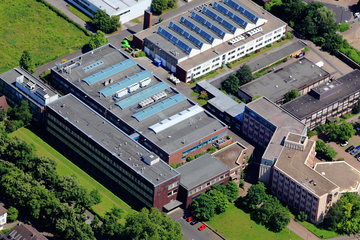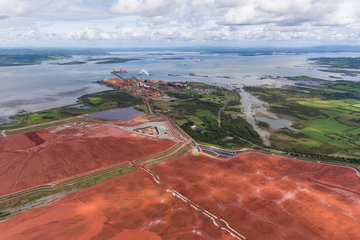A material that keeps its cool when hot
A great deal of energy could be saved if turbines and combustion engines operated at higher temperatures than they currently do. Ceramic high-temperature materials make this possible. Martin Jansen, Director at the Max Planck Institute for Solid State Research in Stuttgart, has been conducting research into just such a new material for 20 years. It is now ready for the market.
Text: Roland Wengenmayr

Anyone who discusses high-temperature materials with Martin Jansen quickly sorts our world into an imaginary temperature scale. We live at the very bottom, on a small, cool island where solid matter is possible. Above 4,000 degrees Celsius or so, all the solid materials with which we are familiar melt or decompose. When viewed on a cosmic scale, this is not particularly hot – temperatures of 15 million degrees Celsius, for instance, prevail in the center of our Sun.
Jansen presents a diagram that can be read as a kind of treasure map in the search for high-temperature materials. At the top of the hot hit-list is an alloy of tantalum, zirconium and carbon with a decomposition temperature of just under 4,000 degrees Celsius. Carbon follows in second place, at around 3,800 degrees – but not in air, as the oxygen would have caused it to burn up before then. “The sequence of these materials has been the same for 50 years,” explains the chemist, since science has not found a more heat-resistant material during this time. Obviously, even the strongest chemical bonds can hold atoms together as solid matter only at up to around 4,000 degrees Celsius.
Heat-resistant material helps to save energy
But Jansen’s research field lies between 1,000 and 2,000 degrees Celsius. His team in Stuttgart and his cooperation partners are developing new high-temperature materials that can be used in engines and turbines. The winners on the thermal hit-list are, unfortunately, not suitable for this, because materials for such applications must not only withstand high temperatures in the presence of oxygen, they must also cope with strong mechanical loads. In the large steam turbines that generate electrical energy in power plants, for example, the extreme tips of the longest turbine blades rotate at supersonic speed – subjecting them to enormous centrifugal forces.

Thus far, metallic materials have complied best with this spectrum of specifications. But even the most thermally stable alloys “scale” in air and soften above 1,000 degrees Celsius. Although modern aircraft engines and gas turbines in power plants operate at combustion temperatures of up to 1,400 degrees Celsius, a cooling stream of air must protect the metal components from the hot gas. This costs energy and decreases the efficiency of the turbines.
Jansen wants to increase the efficiency of heat engines, including turbines and all combustion engines. According to the laws of physics, their efficiency increases with the operating temperature. This is no less true for the engine of a motor vehicle than for the turbine generator of a power plant. Higher efficiency saves valuable fossil fuel and reduces the emission of climate-damaging carbon dioxide. In addition, combustion chambers that are not cooled reduce the emission of harmful nitrogen oxides.
Heat engines literally drive our society. Given their relevance, it becomes clear why Martin Jansen has been doggedly working on new high-temperature materials for more than 20 years. It is only one of his research fields, of course, but it is obviously close to his heart. The answer to the question as to which materials could adequately replace the metals that have thus far dominated things was obvious to the inorganic chemist way back in the 1980s: only ceramics could provide a solution.

The ceramic high-tech materials that the Stuttgart chemists have been developing ever since, however, have nothing in common with conventional porcelain. A smile passes over Jansen’s face when asked what would happen to the coffee cup on his desk at more than one thousand degrees. “Porcelain is indeed a material that is quite stable at high temperatures,” he explains patiently, “but the cup would ‘flow’ under a mechanical load even at relatively low temperatures.” This high-temperature creep – similar to viscous honey – is the weakness of oxide ceramics, and reason enough to rule out porcelain and similar materials.
But they have an even worse characteristic: if the cup fell to the floor, it would shatter, whereas a metal container would not. Ceramics are hard, but very brittle. Metals, in contrast, are tough and elastic. If necessary, they give by creeping slightly. They age in a way that is well known, and this is decisive for engineers. This is how an aircraft engine manufacturer can state how long a part can remain in operation before having to be replaced. “Conventional ceramic, in contrast, can fail after one hour,” explains Jansen, “or after a hundred thousand hours.”
Disordered network makes ceramics tough
This brittleness is caused by the microstructure of conventional ceramics: they consist of tiny, fused crystals. In such a crystallite, the atoms arrange themselves in a rather orderly fashion to form a three-dimensional spatial lattice. However, its planes, in which the atoms stack up like stories of a building, act like predetermined breaking points. When overloaded, they tear open like the seam of a piece of cloth. When the fracture finally reaches the neighboring crystal, it rapidly forges ahead. “It propagates at the speed of sound,” is how Jansen explains the sudden failure of ceramics.

Although metallic materials also consist of small crystallites, the chemical bonds between the metal atoms behave more like strong, viscous glue. The crystal planes can thus slide past each other under stress without tearing apart. This ductile behavior cannot be transferred to ceramics, because a different type of chemical bond keeps the atoms together here.
So Martin Jansen had to come up with a new concept, which he wrote down already back in 1989 when he was still a professor at the University of Bonn. One key to the new material was the radical abolition of the small crystals. The chemist wanted to develop an amorphous ceramic instead. In amorphous materials, such as types of glass, the atoms form a rather disordered spatial network. Where there is no lattice plane, there is no predetermined breaking point, Jansen thought to himself. This led him to hope that such a ceramic might not fail suddenly due to a brittle fracture – as material scientists would say – but would be impact resistant.
However, atoms tend to form orderly crystals when the melt cools down. This is because they save the most energy in the state of highest order. Only if something strongly interferes with their choreography as they cool down do they remain stuck in an amorphous network. Jansen called on his experience as a chemist to finally select a compound of the elements silicon, boron and nitrogen. A mixture with a ratio of 3:3:7 brings about the desired interference with the crystalline sorting process.
The silicon atoms (Si) want to hold their neighboring atoms with four bonds, like chemical “hands” – boron (B) and nitrogen (N), in contrast, play a three-handed game. The non-integer ratios present the atomic ballet with an insoluble problem – how to grab a partner’s hand with each chemical hand, and at the same time dance into a crystalline order. In the end, almost every hand has grabbed another – but the atomic ballet finishes up as a disorderly knot in the desired network. “The atoms are not intelligent enough to solve this problem,” remarks Jansen.
Many bonds strengthen the atomic chain links
Two further ideas are behind the choice of the chemical bond: every atom in the new Si3B3N7 is bonded to its neighbor via three covalent bonds – four in the case of silicon. This ensures that the energy that keeps the network together is mainly in the bonds between atoms that are direct neighbors, making every atom a strong link in the chain. The second idea is that the high number of bonds also means that an atom can hardly leave its position. Doing so would require it to break at least two of the neighboring bonds simultaneously, which is very unlikely.
Sustainable synthesis from run-of-the-mill chemicals
This makes the new material resistant to high temperatures, even though it is amorphous. Amorphous materials are assumed to be thermally unstable, which is why Jansen had his work cut out for him convincing the materials scientists. The reason, again, is the energy. If one imagines it as a mountainous landscape, the crystals correspond to the rocks that have rolled down into the deepest energy valleys. However, on their fall into the energy valley, rocks, which correspond to amorphous structures, get stuck in an energy hollow on the slope. If increasing temperatures now shake the energy landscape like strong earthquakes, these rocks tend to jump out of their perilous metastable position again: they roll further into the energy valley, and the amorphous structure reorders itself to form a crystal. The material thus radically changes its properties, which would destroy a machine. In the Stuttgart concept, however, the local energy hollows are so deep that the rocks stay inside, and the ceramic material retains its amorphous network.

This project has been aimed at industrial application right from the start. “This is why the synthesis of the precursor molecule was designed to be environmentally and economically sustainable,” says Jansen. All constituents are low-cost, readily available chemicals. The only waste product produced is hydrochloric acid, which can be reused as a chemical.
The manufacture of the ceramic required an unconventional method. The possible solid starting compounds decompose before melting, and after cooling, the desired amorphous network would not be obtained. The network must therefore be constructed step by step from basic molecular components. In the center of these molecules is a nitrogen atom that bonds one silicon and one boron atom. At the edge are groups that act like the components of a superglue. In the second step, the “polycondensation,” they allow the basic molecular components to combine in a flash. “This must work like instant glue,” says Jansen. The polymer network thus formed already largely corresponds to the amorphous structure of the ceramic, but residues of glue still remain between the boron, nitrogen and silicon atoms. In the final step, the chemists heat the polymer in order to drive out these residues. Starting at 600 degrees Celsius, the organic substances escape from the network as pyrolysis gas. The pyrolysis is therefore the only step in the synthesis sequence in which material is lost.
Jansen proudly shows one of the results of 20 years of research: the pitch black fiber was produced from the Stuttgart ceramic by the Fraunhofer Institute for Silicate Research (ISC) in Würzburg, a longstanding cooperation partner. It is surprising that this fluffy material is a ceramic – and that it withstands temperatures above 1,500 degrees Celsius without significant loss of mechanical strength. The new ceramic can be processed in many different ways. It can be ground to a powder, for example, that can be sintered at high temperatures to produce components.
“It is also possible to manufacture coatings or infiltrations,” says Jansen, “and to draw these fibers here.” They are the most developed. At the ISC it is possible to witness how they are manufactured: the Würzburg-based researchers built a pilot plant for this, an intermediate step between laboratory and industrial production. This is where they draw the initially colorless ‘green’ fibers out of the polymer before heating them in an oven. Today, the plant already manufactures 50 kilograms of polymer per run. “We have improved the synthesis again and again, changed the constituents and thus significantly improved the yield and the purity of the ceramic,” says Dieter Sporn, who headed the project at the ISC for many years.
One variation of the fiber whose network also contains carbon in addition to silicon, boron and nitrogen has proven to be particularly heat resistant. This SiBNC fiber withstands temperatures of up to 1,500 degrees Celsius in air without chemically decomposing. “No mass loss occurs in helium, even at temperatures of up to 2,000 degrees,” explains Jansen. The new fiber is thus significantly superior to expensive ceramic fibers made of silicon carbide (SiC), which
are already commercially available. Although it reacts just like these in air with oxygen at 1,500 degrees Celsius, it forms a double layer that protects it from the aggressive oxygen. “The commercial SiC fiber, in contrast, simply corrodes through,” says Jansen.
Material for coated turbine blades

The scientists have proven that the ceramic fiber satisfies the demands of turbine construction. It not only withstands higher temperatures than any metallic material, but it remains mechanically stable in the process. “Compared with other materials, its strength is only average,” says Jansen. “But it almost maintains it even at just over 1,400 degrees Celsius, and is therefore better than all other known materials under these conditions.” A turbine blade made from a ceramic composite with this fiber would weigh only one-third of one of today’s blades made of high-alloy steel. The centrifugal forces would thus be correspondingly lower. Moreover, lighter aircraft engines would save kerosene.
However, it is not possible to simply “weave” a turbine blade from the fiber. The scientists in Stuttgart and their cooperation partners have thus developed a composite: a ceramic made from silicon carbide through which parallel SiBNC ceramic fibers are drawn to provide reinforcement. The most promising approach by far is in the use of ceramic fiber reinforced ceramics to overcome the most critical weakness of this class of materials – their brittleness. In principle, the fibers can be processed like carbon fibers to create composites. The company SGL Carbon in Wiesbaden specializes in just this, and the Fraunhofer researchers have brought them onboard. SGL Carbon plans to produce the fibers on an industrial scale for major customers.
A different recipe for larger components
Work is now being done to improve one important aspect of the new ceramic. Although the polymer can easily be formed into larger components by injection molding, the researchers have thus far been successful in producing only the thin ceramic fibers without defects. Thicker material suffers from high shrinkage, because the organic components vaporize during the firing; the escaping pyrolysis gas causes fissures and holes. Jansen’s team is therefore trying to redesign the polymer chemically so that the organic components remain trapped in the network of the atoms during the firing. They can now report some success: Jakob Wilfert, a doctoral student, proudly hands a laboratory visitor a small piece of ceramic. It is about the size of a fingernail and a few millimeters thick. Its shiny black surfaces contain virtually no bubbles.
“One can rightfully say that this is a new class of material,” says Jansen with satisfaction. After all, he has had to suffer a number of disappointments relating to industrial partners. The Bayer Group, for example, backed out in the 1990s after a partnership of many years. Jansen has experienced that the road from scientific invention to technical application can be a very long one indeed. This applies especially to new high-tech materials for use in aircraft engines, for example. They are required to be tested for many years to establish their safety, so investors have to think long-term.
In 2004, Jansen was awarded the Science Prize of the innovation agency for the German science system (Stifterverband der deutschen Wissenschaft) for the development of the new high-temperature ceramic. Last year, the scientists in Stuttgart and their cooperation partners were even nominated for the German Federal President’s Future Prize. “We managed to get into the final eight,” remarks Jansen, but adds with regret: “It was a bit too early, because the ceramic is not really on the market yet.” Jansen is convinced that the new class of material will achieve a high market volume one day. “At the moment, only high-value applications are possible,” he says. “But the material can, in principle, be used for a very wide variety of applications, similar to steel.”
Glossary
Oxide ceramics
Ceramics that contain oxygen in addition to various metals, such as aluminum or zirconium, for example.
Amorphous ceramics
Unlike conventional ceramics, which consist of small, regularly ordered crystallites, the atoms in amorphous ceramics bond to form a disordered spatial network.
Covalent bond
A chemical bond between two atoms. It is formed by at least one electron pair, to which both atoms contribute one atom each.
Polycondensation
A chemical reaction in which small molecules combine to form a multi-link chain or an extensive three-dimensional network. The by-products are simple chemical compounds, such as hydrogen chloride or water.

















